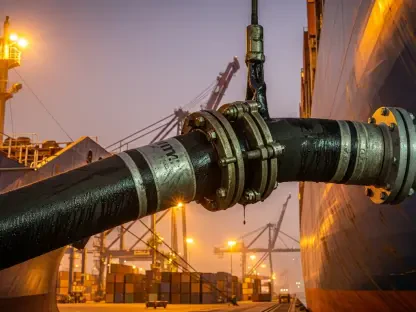Last week, Shell faced an oil spill near Bukom, Singapore, due to a leak in a land pipeline, which released 30 to 40 tonnes of oil. The swift containment efforts by Shell and the Maritime and Port Authority (MPA) successfully minimized environmental damage and ensured maritime navigation safety.
Incident Overview
Shell experienced an oil spill originating from a land pipeline leak in the Bukom region that resulted in the release of approximately 30 to 40 tonnes of oil. The incident was promptly addressed by Shell and the MPA, who swiftly contained the spill to minimize environmental damage. Their combined swift response ensured that the spill was managed effectively, preventing it from impacting maritime navigation in the surrounding waters.
Response Measures
The containment efforts involved deploying various advanced containment booms and boats equipped with dispersants to manage the spread of the oil. Essential to the response were modern technologies including drones and satellites, which provided crucial monitoring capabilities. This technological integration showcases the growing importance of advanced tools in effectively managing environmental incidents such as oil spills.
Environmental and Financial Implications
The incident underscores the substantial environmental risks that accompany oil operations. Although Shell’s swift containment efforts were effective in reducing the ecological impact, the financial repercussions remain significant. Cleanup costs alone represent a large expenditure, and potential increases in carbon taxes in Singapore introduce additional financial challenges. These factors highlight the delicate balance companies must maintain between operational efficiency and environmental stewardship.
Strategic and Regulatory Context
Shell’s operations in Bukom are of considerable scale, processing around 237,000 barrels of crude oil daily and producing various chemicals, including ethylene. The company is currently reviewing its assets, which could indicate a strategic shift towards lower-carbon solutions. This review comes amid increasing regulatory pressures, illustrating the evolving landscape in which oil companies operate, pushing them towards more sustainable practices.
Energy Transition
The spill accentuates the growing difficulties faced by maintaining oil infrastructures in environmentally sensitive areas. Shell’s consideration of selling some of its assets aligns with its broader strategy of energy transition. As the company aims to move towards sustainability and regulatory compliance, this incident further cements the need for the oil industry to adapt swiftly to changing norms and expectations.
Overarching Trends and Consensus
Several overarching trends emerge from this incident. The integration of technology, such as drones and satellites, played a crucial role in the response in effectively managing the situation. This underscores a broader trend in the industry towards the adoption of advanced technologies for environmental management. There is also a heightened focus on mitigating ecological impacts, reflecting the industry’s shift towards environmental responsibility.
The financial and regulatory pressures, exemplified by increasing carbon taxes in Singapore, signal stronger regulatory frameworks that encourage oil companies to pursue sustainable practices. Finally, Shell’s potential asset sales indicate an industry-wide shift towards sustainability, adapting to both environmental and regulatory demands.
Conclusion
Last week, an oil spill took place near Bukom, Singapore, involving Shell. The incident occurred due to a leak in a land pipeline, which resulted in the release of 30 to 40 tonnes of oil. This event raised immediate concerns about possible environmental damage and the safety of maritime navigation in the area. Fortunately, both Shell and the Maritime and Port Authority (MPA) responded swiftly to the situation. They acted promptly to contain the spill, which helped to effectively minimize the environmental impact. The efforts involved quick deployment of containment equipment and resources to control the spread of the oil. By working efficiently, Shell and the MPA were able to ensure that the spill did not pose a significant threat to maritime navigation. Their rapid response highlights the importance of having emergency protocols and resources in place for such incidents. The collaborative efforts of these organizations played a crucial role in mitigating the potential adverse effects on the environment and maintaining safety in the affected region.









